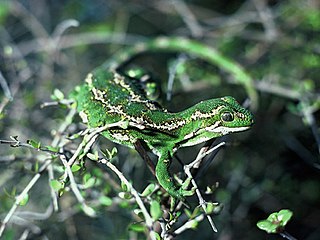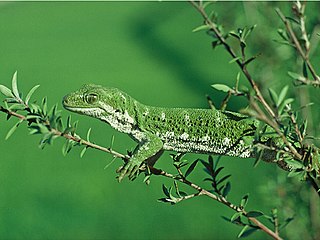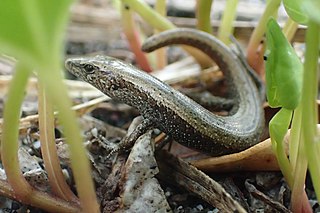
Naultinus is a genus of geckos that are endemic to New Zealand. On account of their striking colouration, species in the genus Naultinus are commonly known as green geckos. There are nine described species in the genus. Species in the genus share a number of traits that set them apart as quite different from the rest of the world's two thousand odd gecko species, which are generally brown in colour, ovivaparous, short-lived and nocturnal. In contrast, Naultinus are green, ovovivaparous, live up to 30 years or more and are strictly diurnal. New Zealand has a temperate, maritime climate, and in terms of distribution Naultinus is one of the southernmost gecko genera in the world — some species live in habitats in the South Island which receive regular snowfall in winter. Animals in this genus possess several physiological and behavioural adaptations to cope with these periods of low temperatures and adverse weather.

Gigarcanum delcourti, formerly Hoplodactylus delcourti, is an extinct species of gecko in the family Diplodactylidae. It is the largest known of all geckos, with a snout-to-vent length (SVL) of 37 cm (14.6 in) and an overall length of at least 60 cm (23.6 in). It is only known from a single taxidermied specimen collected in the 19th century that was rediscovered unlabelled in a museum in France. The origin of the specimen was undocumented. While originally suggested to have been from New Zealand and the kawekaweau of Māori oral tradition, DNA evidence from the specimen suggests that it originates from New Caledonia.

The Auckland green gecko, also known as the elegant gecko, is a species of gecko found only in the northern half of the North Island of New Zealand, except north of Whangaroa.

The Wellington green gecko is a species of gecko found only in the southern half of the North Island of New Zealand. It was previously considered a subspecies of the Auckland green gecko, and together called the common green gecko.

The black-eyed gecko, also known commonly as Whitaker's sticky-toed gecko, is a species of lizard in the family Diplodactylidae. An alpine gecko species, discovered in 1970, it inhabits high-altitude mountains in three areas of the South Island of New Zealand. It is the highest-altitude lizard species in New Zealand, living up to 2,200 m (7,200 ft) above sea level.

The harlequin gecko, formerly Hoplodactylus rakiurae, is a species of gecko, a lizard in the family Diplodactylidae. The species is endemic to Stewart Island / Rakiura in the far south of New Zealand, where it was discovered in 1969. In terms of distribution it is one of the southernmost gecko species in the world.

The Stephen's Island gecko, also known commonly as the Cook Strait striped gecko, Stephen's sticky-toed gecko, and the striped gecko, is a species of gecko in the genus Toropuku in the family Diplodactylidae. The species is endemic to New Zealand.

The rough gecko is a species of gecko in the family Gekkonidae native to New Zealand. It is endemic to the Kaikōura Ranges.

The jewelled gecko is a threatened species of lizard in the family Diplodactylidae. The species is endemic to the South Island of New Zealand.

The Marlborough green gecko, also known as the manuka gecko,(Naultinus manukanus) is a small species of gecko endemic to New Zealand. It grows to a maximum of 70mm, and is green, with some individuals displaying gold markings. The underside of the gecko is a lighter green in females, and silvery in males. The holotype is in the collection of the Museum of New Zealand Te Papa Tongarewa.

The Nelson green gecko or starred gecko is a species of the family Gekkonidae (gecko). The neotype is in the collection of the Museum of New Zealand Te Papa Tongarewa.

The West Coast green gecko is a species of the family Gekkonidae (gecko).

The forest gecko is a species of gecko that is endemic to New Zealand. Its Māori name is moko pirirākau. It is found in all parts of the country except the Far North and Canterbury. It is a protected species under the Wildlife Act 1953.

Woodworthia maculata, also known as the New Zealand common gecko or Raukawa gecko, is a species in the family Diplodactylidae. The species is endemic to New Zealand.

Pristurus carteri, commonly known as Carter's rock gecko or Carter's semaphore gecko, is a species of gecko, a lizard in the family Sphaerodactylidae.

Oligosoma smithi, commonly known as the shore skink, short-tailed skink, Smith's ground skink, Smith's moco, and Smith's skink, is a species of lizard in the family Scincidae (skinks) that is native to New Zealand.

The brown skink is a species of skink native to New Zealand.

Pygopodoidea is a gecko superfamily and the only taxon in the gekkotan subclade Pygopodomorpha. The clade includes three Australasian families: Diplodactylidae, Carphodactylidae, and Pygopodidae. Traditional gekkotan systematics had considered Diplodactylidae and Carphodactylidae as subfamilies of the family Gekkonidae, but recent molecular work have placed Pygopodidae within Gekkonidae making it paraphyletic. These analyses have shown support of Pygopodidae and Carphodactylidae being sister taxa, with Diplodactylidae occupying a basal position in Pygopodoidea.

The Aupōuri green gecko, also known as the North Cape green gecko or yellow-lipped green gecko, is a species of gecko in the family Diplodactylidae. While the existence of the species was known for many years, it was undescribed until early 2021, with its scientific name being Naultinus 'North Cape' prior to description as N. flavirictus.





















